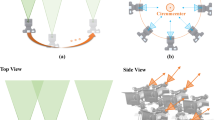Abstract
Previous joint/guided filters directly transfer structural information from the reference to the target image. In this paper, we analyze the major drawback—that is, there may be completely different edges in the two images. Simply considering all patterns could introduce significant errors. To address this issue, we propose the concept of mutual-structure, which refers to the structural information that is contained in both images and thus can be safely enhanced by joint filtering. We also use an untraditional objective function that can be efficiently optimized to yield mutual structure. Our method results in important edge preserving property, which greatly benefits depth completion, optical flow estimation, image enhancement, stereo matching, to name a few.













Similar content being viewed by others
References
Arbeláez, P., Pont-Tuset, J., Barron, J. T., Marques, F., & Malik, J. (2014). Multiscale combinatorial grouping. In CVPR.
Carlo, T., & Roberto, M. (1998). Bilateral filtering for gray and color images. In ICCV.
Chen, J., Paris, S., & Durand, F. (2007). Real-time edge-aware image processing with the bilateral grid. ACM Transactions on Graphics, 26(3), 103.
Criminisi, A., Sharp, T., Rother, C., & Perez, P. (2010). Geodesic image and video editing. ACM Transactions on Graphics, 29(5), 134.
Farbman, Z., Fattal, R., Lischinski, D., & Szeliski, R. (2008). Edge-preserving decompositions for multi-scale tone and detail manipulation. ACM Transactions on Graphics, 27(3), 67:1–67:10.
Farbman, Z., Fattal, R., & Lischinski, D. (2010). Diffusion maps for edge-aware image editing. ACM Transactions on Graphics, 29(6), 145.
Fattal, R. (2009). Edge-avoiding wavelets and their applications. ACM Transactions on Graphics, 28(3), 22:1–22:10.
Frédo, D., & Julie, D. (2002). Fast bilateral filtering for the display of high-dynamic-range images. ACM Transactions on Graphics, 21(3), 257–266.
Gastal, E. S., & Oliveira, M. M. (2011). Domain transform for edge-aware image and video processing. ACM Transactions on Graphics, 30(4), 69.
Gastal, E. S., & Oliveira, M. M. (2012). Adaptive manifolds for real-time high-dimensional filtering. ACM Transactions on Graphics, 31(4), 33.
He, K., Sun, J., & Tang, X. (2010). Guided image filtering. In ECCV.
Hosni, A., Rhemann, C., Bleyer, M., Rother, C., & Gelautz, M. (2013). Fast cost-volume filtering for visual correspondence and beyond. IEEE Transactions on Pattern Analysis and Machine Intelligence, 35(2), 504–511.
Krishnan, D., & Fergus, R. (2009). Dark flash photography. ACM Transactions on Graphics, 28(3).
Lu, S., Ren, X., & Liu, F. (2014). Depth enhancement via low-rank matrix completion. In CVPR.
Ma, Z., He, K., Wei, Y., Sun, J., & Wu, E. (2013). Constant time weighted median filtering for stereo matching and beyond. In ICCV.
Paris, S., & Durand, F. (2006). A fast approximation of the bilateral filter using a signal processing approach. In ECCV.
Paris, S., Kornprobst, P., Tumblin, J., & Durand, F. (2009). Bilateral filtering: Theory and applications. Foundations and Trends in Computer Graphics and Vision, 4(1), 1–74.
Park, J., Kim, H., Tai, Y., Brown, M. S., & Kweon, I. (2011). High quality depth map upsampling for 3d-tof cameras. In ICCV.
Petschnigg, G., Szeliski, R., Agrawala, M., Cohen, M., Hoppe, H., & Toyama, K. (2004). Digital photography with flash and no-flash image pairs. ACM Transactions on Graphics, 23(3), 664–672.
Raskar, R., Ilie, A., Yu, J. (2004). Image fusion for context enhancement and video surrealism. In NPAR.
Rudin, L. I., Osher, S., & Fatemi, E. (1992). Nonlinear total variation based noise removal algorithms. Physica D: Nonlinear Phenomena, 60(1), 259–268.
Scharstein, D., & Szeliski, R. (2002). A taxonomy and evaluation of dense two-frame stereo correspondence algorithms. International Journal on Computer Vision, 47(1–3), 7–42.
Shen, X., Xu, L., Zhang, Q., & Jia, J. (2014). Multi-modal and multi-spectral registration for natural images. In ECCV.
Shen, X., Zhou, C., Xu, L., & Jia, J. (2015). Mutual-structure for joint filtering. In ICCV, pp 3406–3414.
Shih, Y., Paris, S., Durand, F., & Freeman, W. T. (2013). Data-driven hallucination of different times of day from a single outdoor photo. ACM Transactions on Graphics, 32(6), 200:1–200:11.
van de Weijer, J., & van den Boomgaard, R. (2001). Local mode filtering. In CVPR.
Xiao, J., Cheng, H., Sawhney, H. S., Rao, C., & Isnardi, M. A. (2006). Bilateral filtering-based optical flow estimation with occlusion detection. In ECCV.
Xu, L., Jia, J., & Matsushita, Y. (2012a). Motion detail preserving optical flow estimation. IEEE Transactions on Pattern Analysis and Machine Intelligence, 34(9), 1744–1757.
Xu, L., Yan, Q., Xia, Y., & Jia, J. (2012b). Structure extraction from texture via relative total variation. ACM Transactions on Graphics, 31(6), 139.
Yan, Q., Shen, X., Xu, L., Zhuo, S., Zhang, X., Shen, L., & Jia, J. (2013). Cross-field joint image restoration via scale map. In ICCV.
Yang, Q. (2012). Recursive bilateral filtering. In ECCV.
Yang, Q. (2014). Stereo matching using tree filtering. IEEE Transactions on Pattern Analysis and Machine Intelligence, 37(4), 834–846.
Yang, Q., Tan, K. H., & Ahuja, N. (2009). Real-time o(1) bilateral filtering. In CVPR.
Zhang, Q., Shen, X., Xu, L., & Jia, J. (2014a). Rolling guidance filter. In ECCV.
Zhang, Q., Xu, L., & Jia, J. (2014b). 100+ times faster weighted median filter. In CVPR.
Acknowledgements
This research is supported by the Research Grant Council of the Hong Kong Special Administrative Region under Grant Number 413113.
Author information
Authors and Affiliations
Corresponding author
Additional information
Communicated by Rene Vidal, Katsushi Ikeuchi, Josef Sivic, Christoph Schnoerr.
Appendix: Proof of Claim 4.1
Appendix: Proof of Claim 4.1
Proof
In Eq. (5), \(e(I_p,G_p)\) reaches the minimum when setting the derivatives \(\frac{\partial e(I_p,G_p)^2}{\partial a_p^1}\) and \(\frac{\partial e(I_p,G_p)^2}{\partial a_p^0}\) to zeros, which yields
where \(\overline{I}_p\) and \(\overline{G}_p\) are the mean intensities of patches centered at p on I and G respectively. By simply substituting \(a_p^1\) and \(a_p^0\) into Eq. (5) and arranging it according to Eq. (1), we obtain
as shown in Eq. (6). \(\square \)
Rights and permissions
About this article
Cite this article
Shen, X., Zhou, C., Xu, L. et al. Mutual-Structure for Joint Filtering. Int J Comput Vis 125, 19–33 (2017). https://doi.org/10.1007/s11263-017-1021-y
Received:
Accepted:
Published:
Issue Date:
DOI: https://doi.org/10.1007/s11263-017-1021-y




